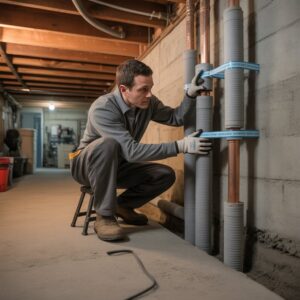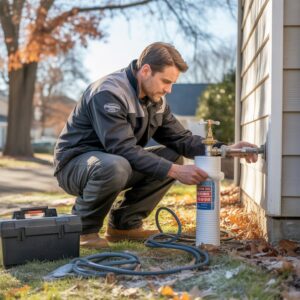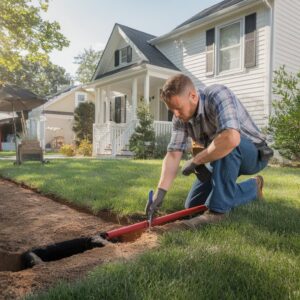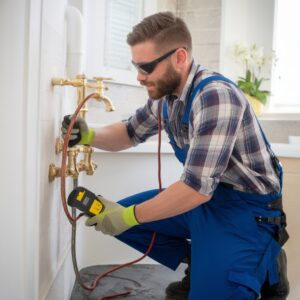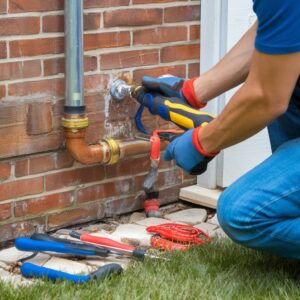To test a backflow preventer, gather the necessary test kit, hoses, gauges, and adapters. Verify all test cocks and shut-off valves are accessible and operational. Check the calibration of the test kit. Close the downstream shut-off valve to build pressure, and connect the kit to measure pressure differential and valve function. Record and analyze the results to confirm performance standards are met. More insights on troubleshooting and post-test compliance await those who proceed.
Key Takeaways
- Gather necessary test equipment: test kit, hoses, gauges, and adapters.
- Ensure test cocks and shut-off valves on the preventer are accessible and operational.
- Close the downstream shut-off valve to build pressure and begin testing.
- Monitor the relief valve for leakage, ensuring it opens at two psi.
- Document all test results and verify compliance with regulatory standards.
How to Test a Backflow Preventer?
To accurately test a backflow preventer, technicians must first guarantee the test kit and tools are prepared, including pressure gauges and hoses.
Testing the relief valve involves methodically opening and closing test cocks to monitor for leaks and proper operation.
It is essential to assess the pressure differential and verify water pressure to confirm the preventer’s functionality and compliance with safety standards. Regular testing helps keep your backflow prevention system operating efficiently and protects against contamination.

Preparing Your Test Kit and Tools
An essential first step in testing a backflow preventer involves gathering and organizing the appropriate test kit and tools required for the task.
The test kit typically includes test kit hoses, gauges for measuring water pressure, and various adapters. A licensed plumber should guarantee that the test cocks on the backflow preventer are accessible and operational.
Before commencing, all shut-off valves should be in the correct position to facilitate accurate readings. The plumber should identify the check valve location within the system.
A detailed inspection report will be crucial to document the findings. Confirming that the test kit is calibrated and in good condition is crucial for precise results.
Proper preparation will streamline the testing process, guaranteeing compliance and functionality.
Steps to Test the Relief Valve
Initiating the testing of the relief valve begins with ensuring the system is under normal operating pressure. The backflow preventer should be connected to a stable water supply.
Verify that all shut-off valves are open to allow water flow. The relief valve test is essential to prevent contamination in the downstream water system.
By closing the downstream shut-off valve, pressure builds, prompting the relief valve to open if functioning correctly. This verifies the relief valve’s ability to maintain a pressure differential, which is vital for system integrity.
Monitor the valve for any leakage or failure to open. If the relief valve fails the test, it demonstrates a potential compromise in preventing backflow and requires immediate attention to protect the water supply.
Checking for Pressure Differential and Water Pressure
Monitoring the pressure differential and water pressure is an essential aspect of testing a backflow preventer. A technician must assess the pressure inside the valve to verify effective backflow prevention. Testing performed involves evaluating both the check valves and the test of the relief components. The pressure differential, vital for reliable backflow, should be measured accurately. After setup, technicians typically backflow turn on the water to begin testing. Using calibrated devices, they must document findings to maintain system integrity.
| Parameter | Ideal Value/Range |
|---|---|
| Inlet Water Pressure | 60-80 psi |
| Outlet Water Pressure | 55-75 psi |
| Pressure Differential | Minimum 5 psi |
| Check Valve Function | No Reverse Flow |
| Relief Valve Test | Opens at two psi |
Confirming these parameters align with standards guarantees a reliable backflow system, safeguarding against contamination.
How Do You Troubleshoot and Interpret the Results of a Backflow Preventer Test?
Interpreting the results of a backflow prevention and testing is essential for evaluating the integrity of the plumbing system.
If the device fails the test, it indicates potential contamination risks and necessitates immediate corrective actions, such as cleaning, repair, or replacement.
Troubleshooting common issues involves checking for debris, valves to ensure alignment, and verifying that test cocks are properly sealed and functioning.
What do the test results indicate about the system’s condition?
When faced with the results of a backflow preventer test, how does one diagnose the system’s condition accurately? The test provides critical insights into the functionality of valves to guarantee clean water is maintained.
If the water pressure inside the valve is insufficient, it can lead to a relief valve opening, indicating potential contamination from cross-connections. A failure to shut off the water supply effectively could allow contaminated water to mix with potable sources, posing a potential health crisis.
The presence of leakages during the test suggests compromised integrity, which could exacerbate the risk of water contamination. Consequently, interpreting these results demands a careful evaluation of each component to prevent hazards and maintain the integrity of the water supply system.
What should you do if the backflow preventer fails the test?
If a backflow preventer fails the test, immediate action is essential to safeguard the water supply. An inspection should be conducted to determine the cause of failure, focusing on valve integrity and potential contamination risks. Depending on the severity, options include repair or replacement to restore the plumbing system’s ability to protect potable water from contamination.
| Action | Description |
|---|---|
| Inspection | Check valve and system components for defects. |
| Repair | Fix malfunctioning parts to prevent backflow risks. |
| Replacement | Install a new unit if repair is insufficient. |
It is important to guarantee that any repair or replacement aligns with local regulations and standards. Proper documentation of the test failure and subsequent actions is necessary to maintain compliance and prevent future issues in the plumbing system.
How can you troubleshoot common issues during testing?
Why do backflow preventer tests sometimes yield unexpected results? Often, issues arise from inadequate pressure within the system, improper installation, or unnoticed cross-connections.
To troubleshoot, first inspect the backflow preventer device for signs of leakage, such as a persistent drip or visible wear. Verify that the pressure settings align with manufacturer specifications. If flow reversal is detected, confirm that all shut-off valves are fully operational and not contributing to the issue—remember, water should be trying to move in only one direction through the system.
Backflow preventers must be installed correctly to function as intended. Testing must also include a thorough examination of contaminants within the system, as these can affect performance. If a cross-connection is suspected, evaluate all plumbing connections for potential breaches.
What Are Post-Test Procedures and Compliance for Backflow Preventers?
After testing a backflow preventer, it is vital to maintain accurate records that include test results, device serial numbers, and the technician’s credentials.
These records should be submitted to relevant authorities or clients, guaranteeing that all stakeholders have access to the certification of compliance.
In industries like HVAC and plumbing, maintaining such documentation is especially critical. To secure ongoing adherence to local regulations, it is advisable to schedule regular inspections and keep updated on any changes in regulatory requirements.
What records should be kept after a backflow prevention testing?
Proper documentation is essential following the testing of a backflow preventer to verify compliance with regulatory standards and facilitate future inspections.
Once testing is completed, maintaining accurate records is vital for property owners to guarantee water safety and prevent contamination.
These records should include:
- Test Results: Detailed results from the service provider, confirming the functionality and condition of the backflow preventer during the annual testing.
- Testing Date: The exact date when the backflow preventer was tested, which is important for scheduling subsequent tests as required by the local municipality.
- Service Provider Information: Provide the contact details of the certified professional who performed the test.
Comprehensive records protect potable water supplies and assist property owners in demonstrating compliance with local regulations.
Who should receive the test report or certification?
Following the meticulous documentation of test results, it is imperative to identify the appropriate recipients for the backflow preventer test report or certification.
Primarily, the property owner should receive this documentation to guarantee compliance with backflow prevention testing requirements. In commercial applications, facility managers are also key recipients due to their responsibility for maintaining clean water lines and addressing plumbing needs.
Additionally, local water authorities require a test report to verify the integrity of the water main and connected systems. The certification should include detailed information about the backflow device, including any findings related to the downstream shut-off valve.
Confirming that all relevant parties receive this documentation is essential for maintaining an effective backflow prevention strategy and safeguarding public health.
How can you ensure future compliance with local regulations?
Guaranteeing future compliance with local regulations for backflow preventers requires a systematic approach to post-test procedures.
Regular testing and maintenance are essential to uphold water safety and prevent contamination. Here are the key steps:
- Inspection and Certification: Conduct thorough inspections and obtain certification from qualified professionals to verify compliance with local regulations and plumbing codes.
- Documentation and Record-Keeping: Maintain accurate records of all testing, inspections, and maintenance activities. Documentation guarantees traceability and aids in demonstrating compliance during audits.
- Scheduled Maintenance and Installation Checks: Implement a regular schedule for maintenance and inspection of the backflow preventer. Verify the installation adheres to current standards, enhancing reliability and effectiveness.
Adhering to these steps guarantees ongoing compliance, safeguarding public health and the integrity of water supply systems.

Common Backflow Test Procedures
Common backflow test procedures involve a systematic approach to ensuring the integrity and functionality of the system.
Technicians must meticulously inspect the two check valves for any signs of wear or malfunction while also testing cocks and shut-off valves to verify proper operation.
Accurate documentation of the testing performed is essential for annual compliance and serves as a record for future reference.
Inspecting the Double Check Valves
Inspecting the double check valves is a critical step in the process of testing backflow preventers, serving as a safeguard against contamination in potable water systems.
Double check valves guarantee that water flows in only one direction, preventing backflow due to back pressure or back siphonage.
When testing a backflow preventer, technicians must follow specific procedures:
- Hook up the test kit: Properly connect the test equipment to measure the pressure differential across the check valves accurately.
- Evaluate the check valves: Confirm that they open at the correct pressure and close tightly when back pressure is applied.
- Analyze the results: Verify that both check valves function effectively, maintaining the integrity of the system and preventing potential contamination risks.
How to Test Cocks and Shut-off Valves
Testing cocks and shut-off valves is an essential procedure in maintaining the functionality of backflow prevention systems.
In plumbing, a backflow test involves checking test cocks and shut-off valves to prevent reverse flow of non-potable water into potable supplies. The test begins by closing shut-off valves to isolate the backflow preventer.
Test cocks are then opened sequentially to measure water pressure, ensuring the reduced pressure or double check backflow assembly functions correctly. Monitoring pressure differentials determines the effectiveness of reverse flow prevention.
If discrepancies in water pressure are detected, adjustments are necessary to restore proper operation. This meticulous evaluation safeguards against contamination, ensuring backflow prevention systems operate efficiently.
Accurate testing of these components is critical to maintaining system integrity.
Recording Testing Performed for Annual Testing
When conducting annual testing, it is crucial to meticulously record all procedures and results to guarantee compliance with safety standards and regulatory requirements.
Backflow preventer testing involves multiple steps that must be documented accurately. Key components include:
- Test Procedure: Detail each step conducted during the backflow prevention test, specifying the test equipment used and any anomalies encountered. This facilitates replication and verification of the procedure.
- Test Results: Record the precise measurements obtained, including pressure differentials and any failures detected. This data is essential for evaluating the integrity of the water supply system.
- Record Keeping: Maintain thorough testing documentation. This includes dates, personnel involved, and test outcomes, ensuring that compliance with annual testing mandates is verifiable and traceable.
Proper documentation is fundamental for maintaining regulatory compliance and safeguarding public health.
Consequences of Not Testing Your Backflow Prevention Device?
Failure to regularly test a backflow device can result in the potential contamination of the clean water supply, posing significant health risks.
Without proper testing, back pressure and back siphonage can occur, leading to the reverse flow of contaminants into potable water lines.
This not only jeopardizes the integrity of individual water systems but can also adversely impact the larger water main infrastructure.
Potential Contamination of Clean Water Supply
Neglecting the regular testing of a backflow preventer can lead to significant risks, including the potential contamination of clean water supplies. This is due to the failure of critical components designed to prevent the reversal of flow in plumbing systems. The consequences can be severe:
- Contamination: Without effective backflow prevention, contaminants from wastewater can infiltrate clean water, posing health hazards.
- Failure of Check Valves: Check valves, necessary for preventing backflow, may malfunction if not regularly tested, compromising water safety.
- System Integrity: Regular testing guarantees the integrity of the plumbing system, minimizing risks associated with backflow and maintaining clean water quality.
Testing is essential to safeguard water safety and prevent the adverse effects of contamination in potable water systems.
Risks of Back Pressure and Back Siphonage
Although often overlooked, the risks associated with back pressure and back siphonage are critical concerns in plumbing systems that rely on backflow preventers.
Back pressure occurs when downstream pressure exceeds supply pressure, potentially forcing contaminants into the clean water supply. Back siphonage arises when a significant drop in supply pressure causes reverse flow, drawing pollutants into the system.
These scenarios underscore the necessity of regular testing and maintenance of backflow preventers. The device, equipped with valves, is engineered to mitigate such risks, but its efficacy diminishes without routine inspection.
Neglecting testing can compromise prevention measures, posing a significant risk to water quality. Ensuring the functionality of the backflow preventer is paramount in safeguarding against contamination threats within plumbing systems.
Impact on Your Water System and Water Main
Regular testing and maintenance of backflow preventers are essential to maintaining a secure water system.
Neglecting backflow preventer testing can lead to several adverse consequences impacting the water main and overall system.
Key issues include:
- Contamination Risks: Unchecked backflow through back pressure or back siphonage can allow pollutants to enter the water main, compromising safety.
- System Failures: Plumbing components, including hydrants and reduced pressure principle devices, may malfunction without proper oversight, jeopardizing backflow prevention.
- Increased Repair Costs: Damaged check valves and related plumbing components can lead to costly repairs if not regularly inspected.
Regular testing guarantees the integrity of the backflow preventer, safeguarding the water system from contamination and mechanical failures, which is vital for public health and infrastructure sustainability.
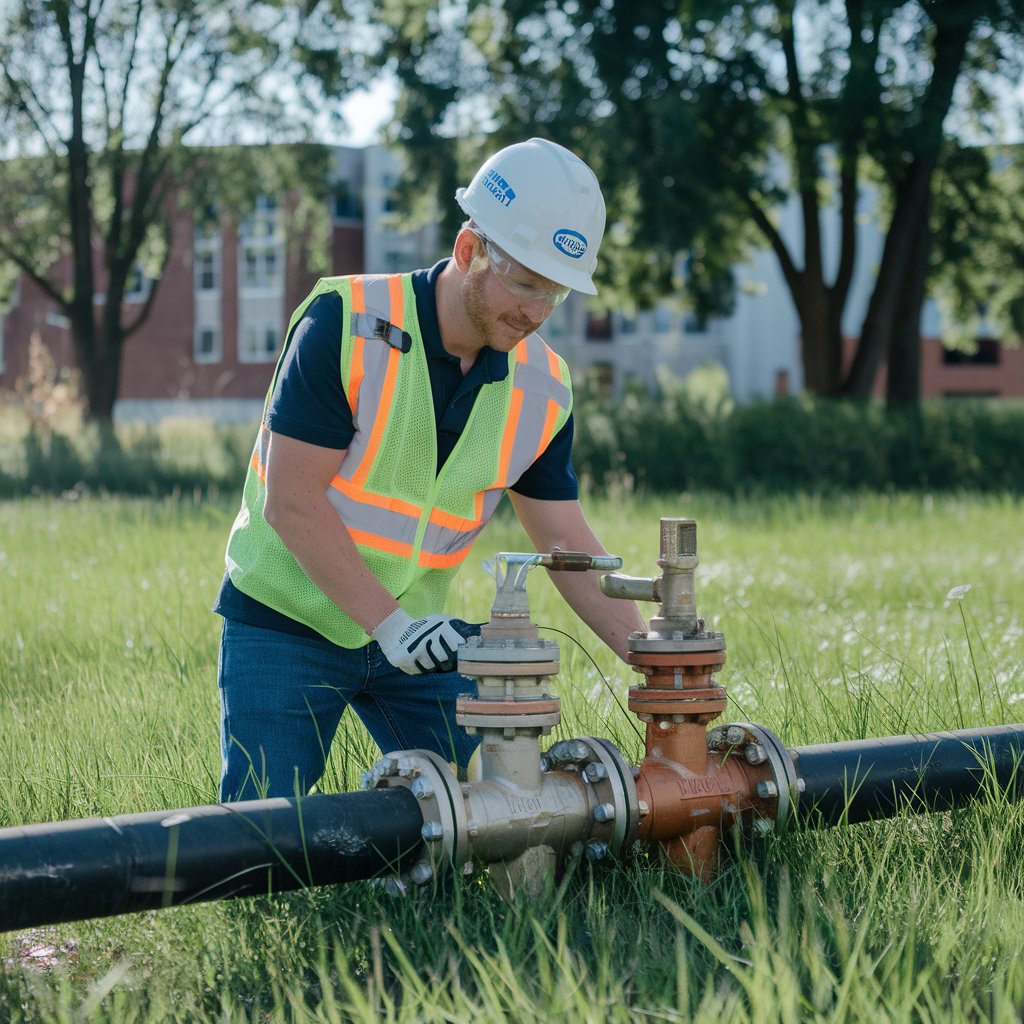
Conclusion
In summary, testing a backflow preventer is vital for maintaining water safety and system integrity. By following systematic procedures, technicians can accurately assess the functionality of these devices, ensuring compliance with regulatory standards. Proper troubleshooting and interpretation of test results help identify potential issues early, reducing the risk of contamination. Post-test procedures further enhance system reliability. Neglecting regular testing can lead to severe consequences, including health hazards and legal liabilities. Consequently, rigorous testing protocols are essential for long-term water safety.

